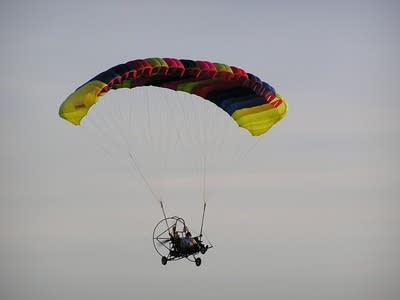The flying photographer
Go Deeper.
Create an account or log in to save stories.
Like this?
Thanks for liking this story! We have added it to a list of your favorite stories.

Maxwell Mackenzie always chooses the window seat in an airplane, even though his tall frame would make you think he'd crave the aisle.
"Someone once said, 'Wings sleep in the dreams of man,'" said Mackenzie, "that we know we're destined to fly. Everybody wants to fly."

Mackenzie has spent years photographing old barns and schoolhouses in the countryside near Fergus Falls, and has published books of his work. But none of those images captured what he saw from up in the air.
So Mackenzie went in search of a flying machine. He tried hot air balloons, paragliders, and ultralight planes. But they either flew too fast or required the pilot to steer with his hands.
Turn Up Your Support
MPR News helps you turn down the noise and build shared understanding. Turn up your support for this public resource and keep trusted journalism accessible to all.
"When I discovered this powered parachute, which only flies at 28 miles or so per hour and you fly with your feet," said Mackenzie, "well, it's about the perfect aerial photography vehicle."
A powered parachute looks like a three wheeled go-cart with a propeller behind it. The cart hangs suspended from a parachute, which inflates with air upon take-off. Mackenzie steers with his feet, pushing down on bars to change directions.

With the powered parachute, Mackenzie can fly just over the treetops, or, if he wants, ascend as high as 10,000 feet.
"I've gone up to 5,000 feet," said Mackenzie, "but the bottoms of my feet start to tingle and I don't like it, so I come down. Most of my photographs are taken between 100 and 500 feet."
From Mackenzie's new vantage point he's able to document a different world, in which fields are transformed into abstract paintings and tree farms read like braille across the countryside.
Fortunately for Mackenzie, the best time to fly -- in the early morning and late evening when the wind is low -- is also the best time to take pictures.

"You do see things up there, particularly at the ends of the day when the light is coming across the earth, and leaving enormous shadows, hundreds of yards long," said Mackenzie. "The earth is revealed in a totally different way. That's the revelation really, is the light."
Because his machine's four-gallon gas tank allows for a maximum of a two-hour ride, Mackenzie's photographs are extremely local, focusing on the farms and fields of Otter Tail County. He published his photographs last year in a book called "Markings."
Mackenzie says his images are not about nature, but about the marks humans leave on the land.
On this evening, it turns out the conditions are perfect for a ride. The wind socks on Mackenzie's land hang motionless. So he warms up the powered parachute and drives it across his 20-acre field to the takeoff strip.

He unpacks the parachute and spreads it out behind the cart, checking the lines to make sure they aren't tangled. The parachute is filled with pockets which trap the air and lift it off the ground.
"The red lines are the steering lines. They're attached to the foot bars, so I want to make sure that those are ready to go," said Mackenzie.
And they are, so it's time for takeoff. Mackenzie throttles the engine and races down the runway. Immediately the parachute begins to fill and lift behind him. By the time he's two-thirds across the field, the parachute is stiff with air and he's aloft, skirting the tree tops and heading out over neighboring farms.
A half hour later Mackenzie is back on the ground, executing a perfect soft landing.
In a couple of weeks he'll pack up and head to Washington D.C., and to his "real job" as a commercial photographer. He'll return next summer.

Mackenzie's relationship to Minnesota has always been like this. He was born in Fergus Falls in 1952, but his family moved away soon after. He was often sent back during summers to stay with his grandparents on Otter Tail Lake.
"And I always [wondered] what would my life have been like here, because this is the only place that I feel at home," said Mackenzie.
When pressed, Mackenzie agrees if he had stayed, it's unlikely he'd be spending his free time taking photographs of farm fields from the air. "I think that you have to go away to come back to see it with new eyes," said Mackenzie. "If I'd grown up here, I don't think I'd be able to see any of this stuff the way I do."
Mackenzie says he's now addicted to taking pictures from the air. He says it requires a level of concentration and coordination that he doesn't use anywhere else.
Twice he's crashed the powered parachute, but both times he's been able to walk away. And so he says each time he flies it reminds him not only that the world is a beautiful place, but that life is both fragile and sweet.






